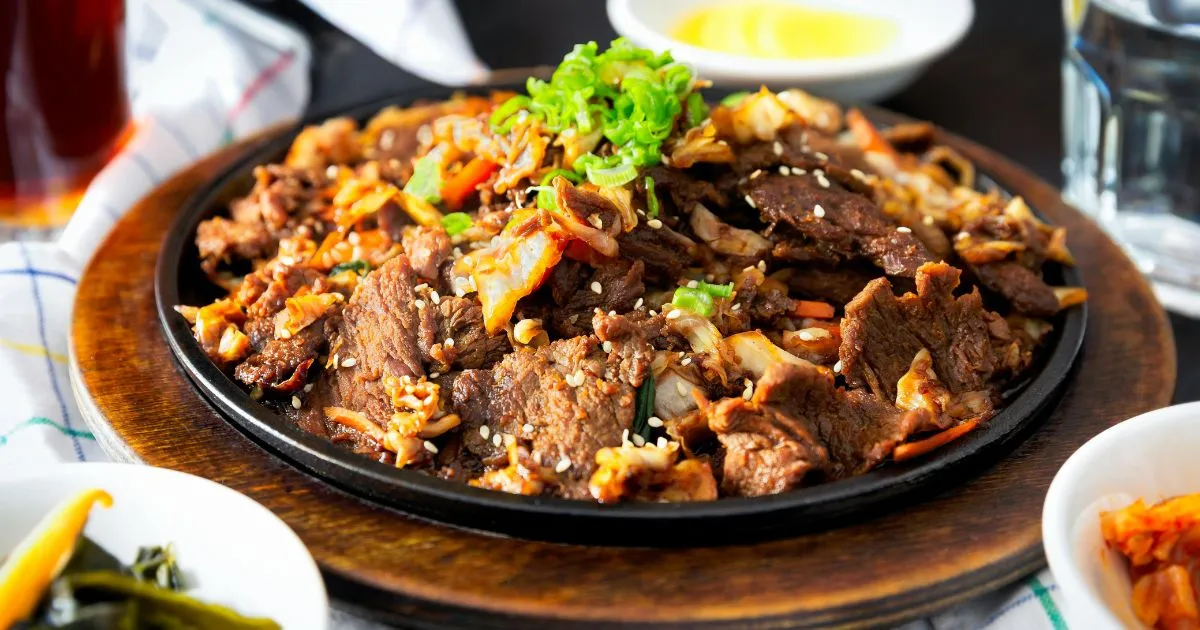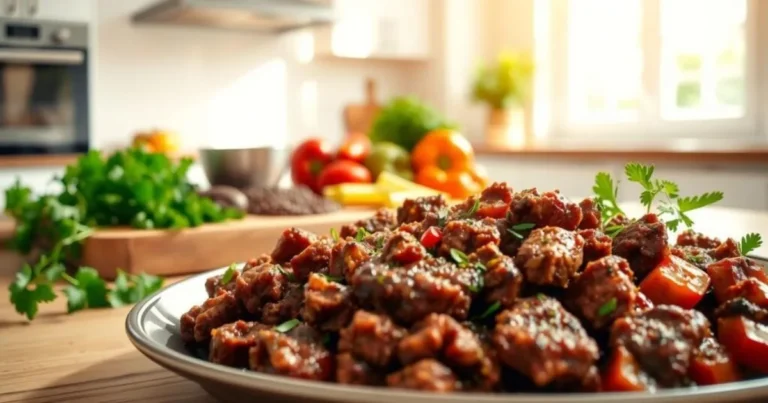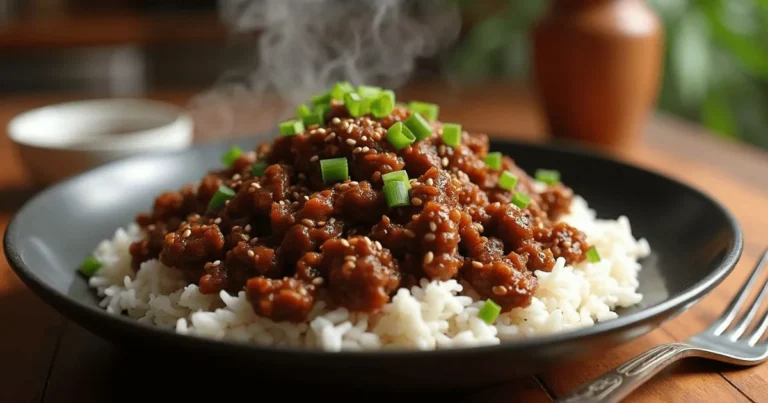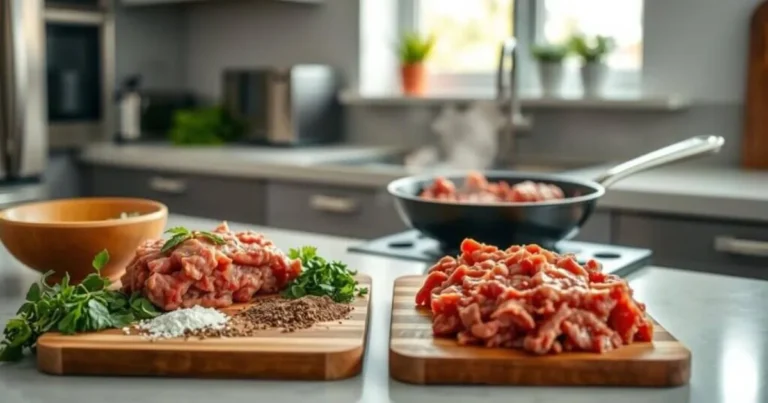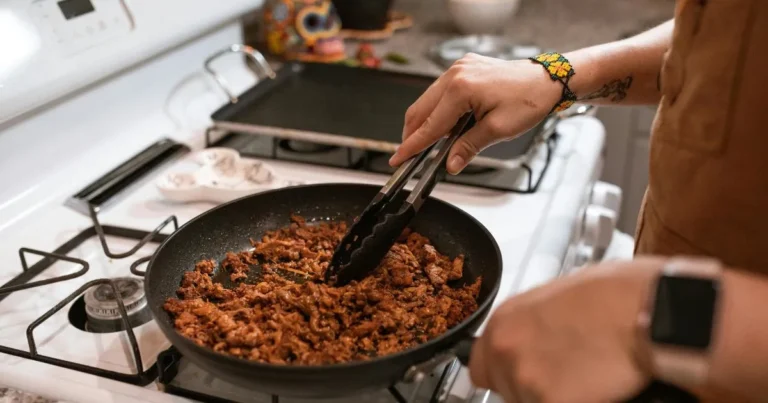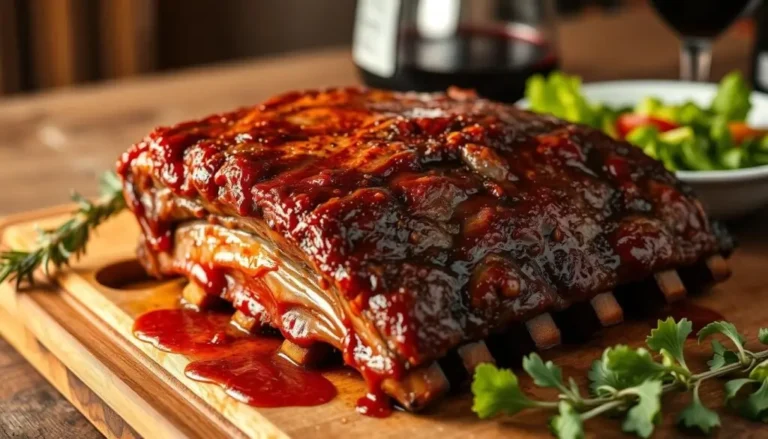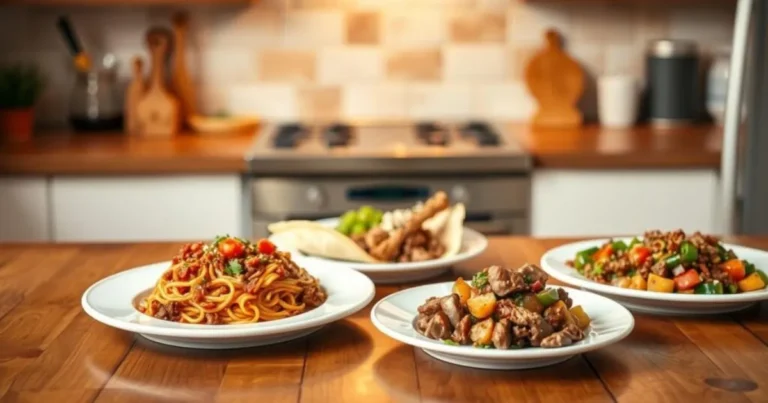How to Make a Beef chow fun recipe
Introduction
The intoxicating aroma of sizzling beef, the satisfying chew of wide rice noodles, and that distinctive smoky “wok breath” – few dishes capture the essence of Cantonese cooking quite like Beef Chow Fun. The first time I encountered this classic stir-fry at a bustling Hong Kong-style diner, I was captivated by how something seemingly simple could deliver such complex flavors and textures.
After countless attempts in my home kitchen – some admittedly more successful than others – I’ve finally perfected an authentic beef chow fun recipe that rivals restaurant versions. The secret lies in solving the two challenges that plague home cooks: achieving true “wok hei” (that distinctive smoky flavor) on standard home equipment and mastering the delicate art of handling those wide, easily-torn rice noodles.
This comprehensive guide focuses specifically on Gon Chow Ngau Ho – the classic “dry-fried” beef chow fun that’s beloved throughout Cantonese cuisine. No soupy sauce, no unnecessary additions – just authentic technique and flavor that would make any Hong Kong chef proud.
Table of Contents
Ingredient Deep Dive
Beef & Marinade
- 340g (12oz) beef flank steak or flat iron steak, sliced thinly against the grain
- 2 teaspoons light soy sauce (not low-sodium)
- 1 teaspoon Shaoxing wine (or dry sherry)
- 1 teaspoon cornstarch
- ½ teaspoon baking soda
- 1 teaspoon neutral oil (peanut or avocado preferred)
- ¼ teaspoon white pepper
- ½ teaspoon sugar
Sauce Mixture
- 2 tablespoons premium light soy sauce (Pearl River Bridge recommended)
- 1 tablespoon dark soy sauce (for color)
- ½ teaspoon sugar
- ¼ teaspoon white pepper
- Optional: ¼ teaspoon MSG or ½ teaspoon chicken powder
Noodles & Vegetables
- 500g (1.1lb) fresh ho fun rice noodles
- 100g (3.5oz) bean sprouts, rinsed and drained thoroughly
- 3-4 stalks Chinese chives or yellow chives, cut into 5cm (2-inch) pieces
- 1 medium yellow onion, sliced into thin strips
- 2-3 thin slices fresh ginger
- 2-3 cloves garlic, thinly sliced
- 3-4 tablespoons high smoke point oil (peanut or avocado oil)
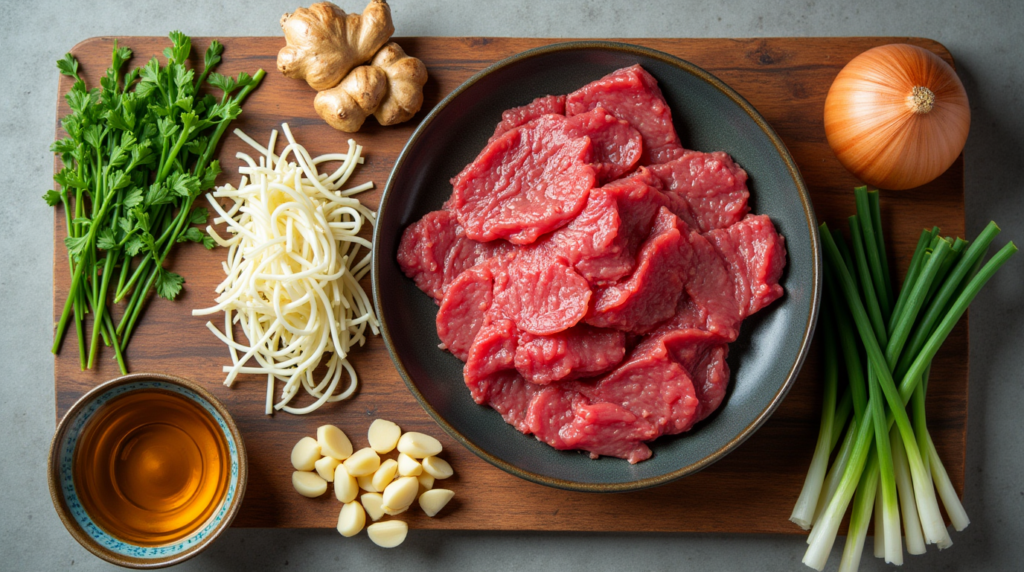
Crucial Ingredient Notes
Noodles (The Foundation of Success)
Fresh ho fun noodles are non-negotiable for authentic beef chow fun. These wide, flat rice noodles should be soft, slightly translucent, and pliable. Look for them in the refrigerated section of Asian markets, often in uncut sheets or pre-cut strips.
Chef’s Tip: For perfect noodle preparation, let refrigerated noodles come to room temperature for 30 minutes before gently separating them. Cold noodles break easily; warm noodles separate willingly. If they’re still sticking, a very brief rinse under warm water helps, followed by thorough draining and a light coating of oil.
If you can only find noodle sheets, cut them into strips approximately 3cm (1.2 inches) wide with a sharp knife. Fresh is always best, but if you must use dried wide rice noodles, follow package instructions but undercook them slightly, as they’ll continue cooking in the wok.
Beef Selection & Preparation
Flank steak is traditional for beef chow fun, offering the perfect balance of tenderness and flavor when properly prepared. Flat iron steak works excellently too. The critical step is the “velveting” technique – a process that creates a protective coating around each slice of beef, keeping it juicy and tender during high-heat stir-frying.
Always slice beef against the grain into thin strips (about 3mm or ⅛ inch thick). Partially freezing the beef for 20-30 minutes makes achieving these thin slices much easier.
Soy Sauce Specifics
The combination of light and dark soy sauces creates the perfect balance of flavor and color:
- Light soy sauce (not “low sodium”) provides the primary savory flavor. Premium light soy sauce like Pearl River Bridge has superior depth.
- Dark soy sauce contributes the characteristic caramel color without overwhelming the dish with saltiness.
Avoid all-purpose soy sauce if possible – the separation of light and dark is what gives authentic beef chow fun its complex flavor profile.
Oil Choice Matters
Peanut oil is traditional and preferred for its high smoke point and subtle flavor that complements the dish. Avocado oil is an excellent alternative with an even higher smoke point. Vegetable or canola oil works in a pinch but lacks the same flavor enhancement.
Essential Equipment
Primary Equipment
- Wok: Carbon steel (14-inch preferred) – the traditional vessel that distributes heat perfectly
- Wok spatula/ladle: The rounded edges prevent noodle tearing
- High-powered burner: Restaurant-level heat helps achieve true wok hei
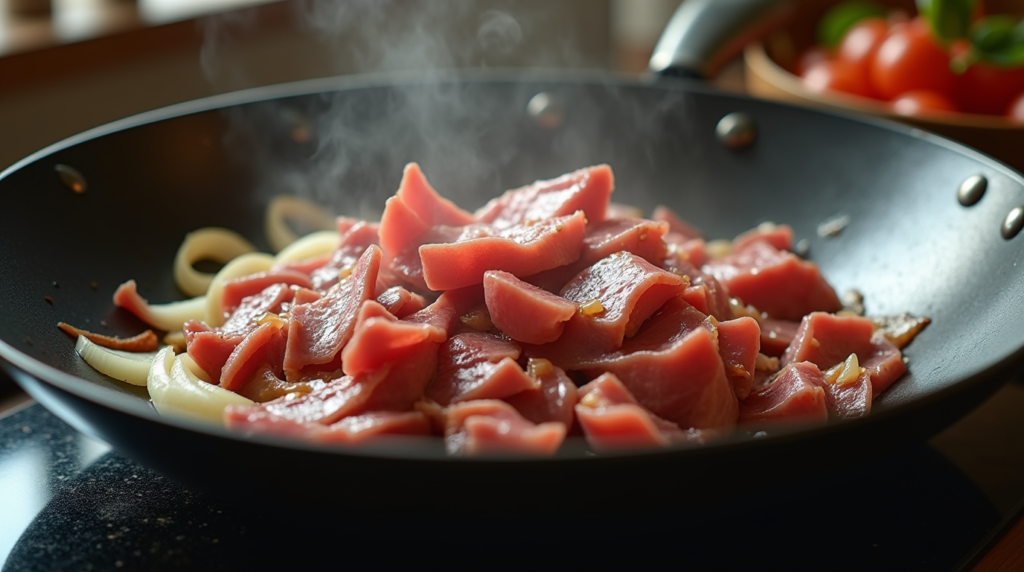
Home Kitchen Adaptations
If using a standard home stove, a well-seasoned cast-iron skillet offers the next best alternative to a wok. When using a standard stove:
- Preheat your pan longer than you think necessary (5+ minutes)
- Work in smaller batches to maintain temperature
- Let the pan reheat between batches
- Consider using a wok ring to concentrate heat if using a wok on an electric stove
The Core Recipe: Step-by-Step Instructions
Phase 1: Preparation
- Prepare beef marinade: Combine sliced beef with light soy sauce, Shaoxing wine, cornstarch, baking soda, oil, white pepper, and sugar in a bowl. Mix thoroughly with your hands, ensuring each slice is coated. Let marinate for at least 20 minutes (up to 2 hours refrigerated).
- Prepare sauce mixture: In a small bowl, combine light soy sauce, dark soy sauce, sugar, white pepper, and MSG/chicken powder if using. Stir until sugar dissolves completely. Set aside.
- Prepare noodles: Gently separate room-temperature ho fun noodles into individual strands. If necessary, briefly rinse under warm water, drain thoroughly, and toss with ½ teaspoon oil to prevent sticking. Do not overhandle – the noodles tear easily.
- Prepare vegetables: Rinse bean sprouts and drain thoroughly (excess water creates steam, preventing proper searing). Cut chives into sections. Slice onion into thin strips. Slice garlic and ginger thinly.
Phase 2: Cooking (High Heat, Quick Action)
- Heat wok properly: Place your wok over high heat until it just begins to smoke. This step is crucial – insufficient heat will result in soggy noodles and no wok hei.
- Sear the beef: Add 1 tablespoon oil to the wok, swirling to coat. Add marinated beef in a single layer and let it sear undisturbed for 30 seconds before stir-frying briefly until the beef is 70% cooked (still slightly pink). Remove to a clean bowl.
- Sauté aromatics: Add another tablespoon of oil to the wok. Add ginger slices and stir briefly until fragrant (about 10 seconds), then add onion and garlic. Stir-fry for 30-45 seconds until aromatic but not browned.
- Master the noodles: Add the final tablespoon of oil, then add separated noodles to the wok. Allow them to sear briefly (10-15 seconds) before gently tossing. Use a scooping motion rather than stirring to prevent breakage.
- Create “wok hei”: Push ingredients to one side of the wok, exposing the hot surface. Pour the sauce mixture onto the hot wok surface (not directly on noodles) and let it bubble for 3-5 seconds to caramelize slightly before tossing everything together.
- Complete the dish: Return beef to the wok along with bean sprouts and Chinese chives. Toss everything together using a scooping motion for 30-45 seconds until well combined and the vegetables are just barely wilted. Do not overcook – the dish should retain fresh textures and colors.
- Serve immediately: Transfer to a warm plate and serve at once. Beef chow fun is at its absolute best when freshly made, with the noodles still slightly chewy and the vegetables crisp.
Mastering Key Techniques
Achieving Wok Hei at Home
Wok hei (literally “breath of the wok”) is that distinctive smoky flavor that defines great Cantonese stir-fries. While difficult to achieve perfectly without restaurant-grade equipment, these techniques will get you remarkably close:
- Proper preheating: Heat your wok or pan until it just begins to smoke before adding any oil. A drop of water should instantly evaporate with a sizzle.
- Oil temperature: When oil ripples and shimmers with slight wisps of smoke, you’ve reached the ideal temperature.
- Cooking in batches: Overcrowding the pan drops the temperature dramatically. For a home stove, never fill your wok more than halfway.
- The “hot spot”: Utilize the center and sides of your wok strategically – the center for searing, the sides for items that need less intense heat.
- Tossing technique: The classic “pull and toss” motion used by professional chefs helps food briefly catch fire as it rises above the wok, contributing to wok hei. For home cooks, this takes practice but is worth learning.
Science Corner: Wok hei comes from a combination of the Maillard reaction (creating hundreds of new flavor compounds through high-heat cooking) and the partial combustion of oil as it vaporizes in the intense heat.
Perfect Noodle Preparation & Handling
Achieving the ideal noodle texture – soft yet chewy with slightly charred edges – requires careful attention:
- Breaking the cold chain: Always let refrigerated noodles reach room temperature before separating.
- Gentle separation: Use your fingers to gently peel noodles apart rather than pulling forcefully.
- Oil protection: A light coating of oil after separation prevents sticking before cooking.
- Minimal movement: When noodles first hit the wok, resist the urge to immediately stir. Let them sear briefly first.
- Proper tools: Use a spatula with rounded edges and a scooping motion rather than a chopstick or fork that might tear the noodles.
- Sauce discipline: Add sauce to the hot wok surface first, not directly onto noodles, to preserve texture and create caramelization.
Velveting Beef Explained
This Chinese technique is the secret to restaurant-quality tender beef:
- The science: Baking soda (alkaline) raises the pH of the meat surface, making it harder for proteins to bond tightly when heated. Cornstarch creates a protective moisture barrier. Together, they prevent the tough contractions that make beef chewy.
- Proper ratio: For every 12oz (340g) of beef, use ½ teaspoon baking soda and 1 teaspoon cornstarch.
- Contact time: 20-30 minutes is ideal for beef chow fun. Less time won’t tenderize enough; much longer can affect texture negatively.
- Even coating: Use your hands (with gloves if preferred) to massage the marinade into every surface of the meat.

Troubleshooting FAQ
Q: Why do my noodles keep breaking apart?
A: This typically happens when noodles are too cold or overhandled. Ensure they’re at room temperature before separating and use a gentle hand both during separation and stir-frying. The scooping motion with a proper wok spatula minimizes breakage.
Q: My beef turned out tough. What went wrong?
A: Three possible issues: insufficient velveting (double-check your baking soda ratio), overcooking (beef should be removed when still slightly pink in step 6), or slicing with rather than against the grain (look for the lines in the meat and cut perpendicular to them).
Q: I’m not getting that restaurant-quality smoky flavor. Help!
A: Wok hei requires extremely high heat. If your home stove isn’t powerful enough, try these tricks: preheat your wok or pan longer (5+ minutes), cook in smaller batches, and make sure your wok is completely dry before heating (water creates steam, preventing proper searing).
Q: My noodles seem greasy. How can I fix this?
A: You might be using too much oil or not having your wok hot enough. The oil should be almost completely absorbed into the dish by the end. If the wok isn’t hot enough, the oil won’t integrate properly with the other ingredients.
Q: The noodles stick together in clumps when cooking. What’s wrong?
A: Either they weren’t properly separated before cooking or your wok wasn’t hot enough when adding them. Always separate thoroughly, add a light coating of oil after separation, and ensure your wok is smoking hot before adding noodles.
Variations & Substitutions
While traditional beef chow fun is perfect as described, these variations respect the dish’s integrity while offering options:
- Protein alternatives: Chicken thigh (velveted similarly to beef), pork loin, or firm tofu (pressed and dried thoroughly before cooking)
- Vegetable additions: Sliced bell peppers, carrots julienned, or Chinese broccoli (add leafy greens at the very end to prevent overcooking)
- Sauce variations: For slight sweetness, add ½ teaspoon oyster sauce; for spice, incorporate a small drizzle of chili oil to finish the dish
Serving & Storage
Beef chow fun is at its absolute peak when served immediately after cooking. The ideal serving style is on a large plate rather than individual bowls, allowing the noodles to spread out rather than clump together.
For leftovers (though purists would argue there shouldn’t be any!):
- Storage: Refrigerate in an airtight container for up to 2 days.
- Reheating: A quick stir-fry in a hot wok with a tiny splash of water is best. Microwaving will make the noodles overly soft.
- Expectations: Be aware that reheated beef chow fun will never match the fresh version – the noodles will soften and the wok hei will diminish.
Conclusion
Mastering beef chow fun at home comes down to understanding two critical elements: achieving proper wok hei through high-heat cooking and handling those delicate rice noodles with care. With the techniques detailed in this guide, you can create a version that captures the authentic essence of this Cantonese classic – smoky, savory, and satisfyingly chewy.
Remember that perfecting this dish might take a couple of attempts as you get comfortable with the rhythm and technique. Each try will bring you closer to that restaurant-quality experience that made you fall in love with beef chow fun in the first place.
Have you tried making this authentic beef chow fun recipe? Let me know in the comments how it turned out, or if you have any other questions! Don’t forget to rate this recipe and share your photos if you make it.
Printable Recipe Card
Authentic Beef Chow Fun (Gon Chow Ngau Ho)
Prep Time: 30 minutes
Cook Time: 10 minutes
Total Time: 40 minutes
Servings: 2-3
Ingredients
- 340g (12oz) beef flank steak, thinly sliced against grain
- 500g (1.1lb) fresh ho fun rice noodles
- 100g (3.5oz) bean sprouts
- 3-4 stalks Chinese chives, cut into 2-inch pieces
- 1 medium onion, sliced
- 2-3 slices fresh ginger
- 2-3 cloves garlic, sliced
- 3-4 tbsp peanut oil
- Full marinade and sauce ingredients as listed above
Instructions
- Velvet beef with marinade ingredients for 20+ minutes
- Separate room temperature noodles gently
- Prepare vegetables and sauce mixture
- Stir-fry beef until 70% cooked, remove
- Sauté aromatics, add noodles and sauce
- Return beef, add vegetables, briefly toss
- Serve immediately
Note: See full instructions above for detailed technique to achieve perfect results.
Leave a Review
I love hearing from you! Submit your question or recipe review here. Your email address will not be published. Required fields are marked *
There are no reviews yet. Be the first one to write one.

